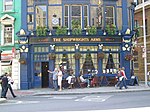London Bridge Area Signalling Centre
Rail transport in LondonSignal boxes in the United KingdomUse British English from March 2017

London Bridge Area Signalling Centre (ASC) was a signalling centre on the Kent Route of Network Rail, principally covering the line from London (Charing Cross, Cannon Street and London Bridge) to Kent and Sussex route areas of Network Rail. The signalling centre was opened in 1974, and closed in 2020.
Excerpt from the Wikipedia article London Bridge Area Signalling Centre (License: CC BY-SA 3.0, Authors, Images).London Bridge Area Signalling Centre
Crucifix Lane, London Borough (London Borough of Southwark)
Geographical coordinates (GPS) Address Nearby Places Show on map
Geographical coordinates (GPS)
| Latitude | Longitude |
|---|---|
| N 51.502527777778 ° | E -0.08225 ° |
Address
Crucifix Lane
Crucifix Lane
SE1 3JW London, Borough (London Borough of Southwark)
England, United Kingdom
Open on Google Maps








